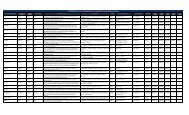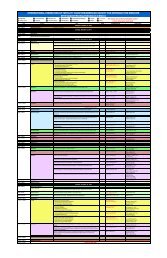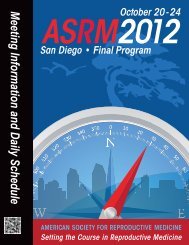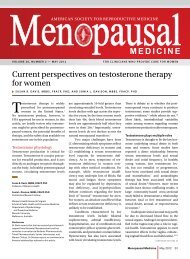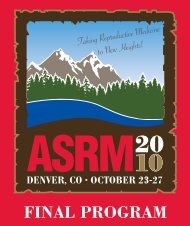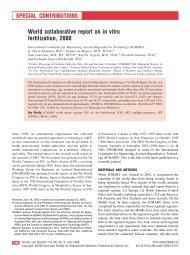scientific program • symposia - American Society for Reproductive ...
scientific program • symposia - American Society for Reproductive ...
scientific program • symposia - American Society for Reproductive ...
Create successful ePaper yourself
Turn your PDF publications into a flip-book with our unique Google optimized e-Paper software.
SCIENTIFIC PROGRAM <strong>•</strong> SYMPOSIA<br />
Monday, October 17, 2011 11:15 am – 1:00 pm<br />
Symposium<br />
Room 222<br />
BUSINESS DEVELOPMENT IN AN UNCERTAIN MARKET<br />
Presented by the Assisted <strong>Reproductive</strong> Managers<br />
Rita Gruber, B.A. (Chair)<br />
<strong>Reproductive</strong> Medicine Associates of New Jersey<br />
Lisa A. Rinehart, R.N, B.S.N., J.D.<br />
<strong>Reproductive</strong> Medicine Institute, Illinois<br />
Joseph J. Travia, B.A., M.B.A., C.P.A.<br />
IntegraMed<br />
Needs Assessment and Description<br />
With the global economic meltdown in 2008 and 2009<br />
along with the current fiscal crisis around the world, how are<br />
practices in reproductive endocrinology and fertility going<br />
to be able to survive and prosper during this difficult time. In<br />
the age of social media and rapidly changing technology<br />
what can practices do to meet the challenges and<br />
opportunities in a new world order focused on the patient<br />
experience?<br />
REI specialists and their staff must work to become the<br />
destination of choice <strong>for</strong> patients in their market. The<br />
patient assumes that your practice is medically and<br />
clinically solid – this is a given. However the patient is<br />
looking <strong>for</strong> and demanding a practice that focuses on the<br />
patient experience from the moment of first contact to<br />
the convenience of office locations, the day-to-day staff<br />
interactions and the handling of the final bill. Discussions will<br />
include all facets of the patient experience, from referring<br />
physicians, education and payers up to and including<br />
their final visit with the fertility center. The components of a<br />
Monday, October 17, 2011 1:00 pm – 2:30 pm<br />
Menopause Day Luncheon Symposium (Ticketed)<br />
TODAY’S APPROACHES TO TREATING THE MENOPAUSE:<br />
RISKS AND BENEFITS OF VARIOUS THERAPIES<br />
Cynthia K. Sites, M.D.<br />
Tufts University<br />
Lubna Pal, M.B.B.S., M.S.<br />
Yale University<br />
Genevieve Neal-Perry, M.D., Ph.D.<br />
Albert Einstein College of Medicine<br />
Needs Assessment and Description<br />
Women and their health care providers are increasingly<br />
confused as to the actual risks/benefits of therapeutic<br />
options available to treat menopausal symptoms and<br />
osteoporosis. Women continue to seek reliable in<strong>for</strong>mation<br />
while also exploring alternative therapies. Despite<br />
considering healthcare providers the most reliable source<br />
of in<strong>for</strong>mation, women expressed low confidence in their<br />
provider’s ability to give sufficient in<strong>for</strong>mation and to<br />
describe alternative therapies. Large gaps exist between<br />
patient expectations and provider preparedness to guide<br />
patient decision making. Selective estrogen reuptake<br />
modulators (SERMs), bisphosphonates, teriparatide,<br />
calcitonin and denosumab are recognized alternatives<br />
to hormone therapy <strong>for</strong> the treatment of osteoporosis.<br />
Tissue selective estrogen complexes (TSECs) that exhibit<br />
tissue specific estrogen agonist/antagonist activity are<br />
emerging as a promising alternative to traditional hormone<br />
therapy <strong>for</strong> the treatment of menopausal osteoporosis.<br />
For menopausal hot flash symptoms, treatments such as<br />
gabapentin, selective serotonin reuptake inhibitors (SSRIs),<br />
and selective norepinephrine reuptake inhibitors (SNRIs)<br />
are considered alternatives to hormone therapy, and<br />
TSECs again represent an emerging option <strong>for</strong> managing<br />
Valencia Ballroom<br />
Supported by an independent educational grant from Pfizer.<br />
66<br />
strategic plan will also be discussed with a focus on practice<br />
development.<br />
Learning Objectives<br />
At the conclusion of this session, participants should be able<br />
to:<br />
1. Identify several external factors that drive the current<br />
models of fertility practices.<br />
2. Develop a comprehensive plan focused on the patient<br />
experience.<br />
3. Discuss a framework <strong>for</strong> strategic planning at a fertility<br />
center.<br />
ACGME COMPETENCY<br />
Systems-Based Practice<br />
TEST QUESTION:<br />
REI practices are becoming increasingly aware that<br />
outstanding medical and clinical care is not enough to<br />
operate a financially successful fertility practice. Designing<br />
a practice around the patient experience and utilizing the<br />
tools available to help you exceed their expectations is<br />
paramount during these difficult times. After participating<br />
in this session, in my practice I will develop a Strategic Plan<br />
that includes each of the following except:<br />
A. Executive Summary<br />
B. Marketing Plan<br />
C. Financial Projections<br />
D. Number of members in AARP by state<br />
E. SART Data<br />
menopausal vaginal atrophy. The decision to use any<br />
therapy depends on a patient’s clinical presentation and<br />
a thorough evaluation of the risks and benefits. In a survey<br />
conducted by ASRM in 2009 and 2011, members identified<br />
personal practice gaps involving the treatment of various<br />
menopausal symptoms and osteoporosis. Physicians<br />
requested educational activities to specifically address their<br />
understanding of individualized treatment approaches.<br />
Learning Objectives<br />
At the conclusion of this session, participants should be able<br />
to:<br />
1. Compare and contrast estrogen therapies versus mixed<br />
agonist/antagonist treatment therapies (SERMs and tissue<br />
selective estrogen complexes,TSECs) in treating<br />
menopausal symptoms<br />
2. Discuss the efficacy, risks, and benefits of mixed agonist/<br />
antagonist agents in the treatment of menopausal<br />
osteoporosis<br />
3. Design treatment plans <strong>for</strong> women of different ages with<br />
menopausal symptoms<br />
ACGME COMPETENCY<br />
Medical Knowledge<br />
Patient Care<br />
TEST QUESTION:<br />
After participating in this session, in my practice I will:<br />
A. Prescribe denosumab <strong>for</strong> perimenopausal women diagnosed<br />
with osteopenia.<br />
B. Prescribe parathyroid hormone to women deemed at high risk <strong>for</strong><br />
fracture.<br />
C. Prescribe TSECs <strong>for</strong> control of vasomotor symptoms.<br />
D. Prescribe SERMs <strong>for</strong> symptomatic women at risk <strong>for</strong> fracture.<br />
E. Not applicable to my area of practice.



